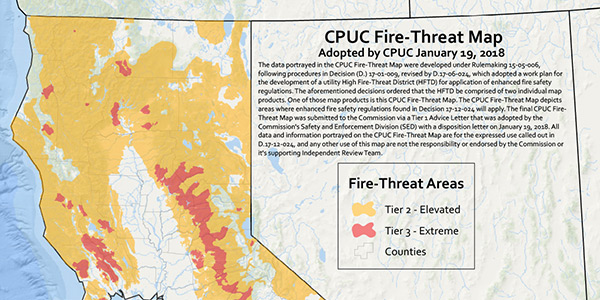By Hudson Sangree
The five members of the California Public Utilities Commission on Thursday unanimously approved wildfire mitigation plans filed by the state’s three large investor-owned utilities in response to last year’s Senate Bill 901.
But they warned that hardening the grid against fires and climate change could be an immense and extremely expensive undertaking.
CPUC President Michael Picker cited Pacific Gas and Electric’s plans to spend $237 million to expand its use of covered conductors along 150 miles of its overhead lines in 2019.
“Assuming that the 7,100 miles of PG&E’s system located in Tier 3 high-fire-threat areas is eventually covered, the magnitude of future general rate case costs could be enormous,” Picker said.
PG&E also intends to clear 305,000 hazardous trees near its lines at an estimated cost of $1.3 billion, he said.
The CPUC announced a series of public hearings Tuesday to consider PG&E’s request for a $2 billion rate hike over the next three years to cover wildfire prevention measures.
On Wednesday, a panel convened by Gov. Gavin Newsom — the Commission on Catastrophic Wildfire Cost and Recovery — issued a draft report and scheduled a June 7 hearing in Sacramento. Its recommendations include replacing the state’s strict liability standard for utilities when electrical equipment starts wildfires — called “inverse condemnation” — with a negligence standard. (See Calif. Must Limit Wildfire Liability, Governor Says.)
PG&E filed for bankruptcy in January, saying it faced at least $30 billion in liability for fires in 2017 and 2018, including the Camp Fire, the deadliest in state history. Southern California Edison also faces massive liability for its equipment’s role in starting the fatal Thomas Fire in 2017. (See Edison Takes Partial Blame for Wildfire in Earnings Call.)
On Thursday, the CPUC approved a proposed decision providing guidance on wildfire plans submitted under SB 901 along with individual decisions on each of the 2019 plans submitted.
In its plan, SCE said it will inspect 450,000 pieces of equipment by the height of the 2019 fire season, Picker said.
“It’s unclear how Southern California Edison can perform detailed inspections of this volume of equipment in so short a time,” he said. “But without better data and a stronger record, we’re not prepared to stop SCE from carrying out its new inspection program. It is required under SB 901 to prove the effectiveness of its inspection program.”
Picker said the commissioners want to make sure that SCE isn’t just doing drive-by inspections or duplicating routine inspections.
Both PG&E and SCE, the state’s first- and second-largest utilities, are playing catchup with smaller San Diego Gas & Electric, which has been hardening its grid and installing cameras and weather stations for a decade in response to catastrophic fires in 2003 and 2007.
While often cited as a model, SDG&E has far less territory to cover than PG&E or SCE, whose systems cover 70,000 and 50,000 square miles respectively. SDG&E’s service territory is 4,100 square miles. (See California Utilities Prepare, as Fire Season Looms.)
“In congratulating SDG&E, I don’t want to underestimate how long it’s going to take for the other utilities to get to that scale,” Commissioner Liane Randolph said. “I just want to make sure that we’re mindful of the heavy lift in terms of expense and time that it’s going to take to implement these plans, and as they get updated in the coming years.”
The CPUC also approved the wildfire mitigation plans of several smaller utilities in California: PacifiCorp, Liberty Utilities and Bear Valley Electric Service. The utilities’ lines run through high-fire-risk areas, commissioners said.
“It’s critical that these utilities have robust and effective mitigation plans as well,” Commissioner Clifford Rechtschaffen said.
Transmission owners NextEra Energy and Trans Bay Cable also had to file wildfire mitigation plans, which the commission approved.
Trans Bay operates a cable that runs under San Francisco Bay and said its cable was “fire-hardened by virtue of being located underwater,” Picker said.
In a separate item on utilities’ plans to de-energize lines in hazardous weather conditions, commissioners insisted that the tool be used only as last resort and not to avoid liability.
De-energization “presents its own safety and health risks,” especially to those who rely on electricity for medical equipment, Rechtschaffen said.

